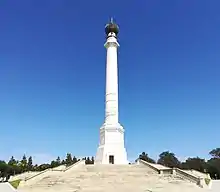Monumento a los Descubridores | |
 | |
| 37°12′28″N 6°55′26″W / 37.207688°N 6.92394°W | |
| Location | La Rábida, Palos de la Frontera, Spain |
|---|---|
| Designer | Ricardo Velázquez Bosco |
| Material | Limestone, concrete, steel |
| Height | 54.90 m |
| Opening date | 12 October 1892 |
| Dedicated to | The explorers of the Americas |
The Monument to the Discoverers or 400th Anniversary Column (Spanish: Monumento a los descubridores or Columna del IV Centenario)[1] is an instance of public art in Palos de la Frontera, Spain. It is dedicated to the "discoverers" of the Americas.
History and description

By 1892, the Provincial Deputation of Huelva tasked Ricardo Velázquez Bosco with the erection of a monument to Columbus and the explorers of the Americas on a plot formerly owned by the House of Alba near the friary of La Rábida.[2]
The monument was unveiled on 12 October 1892,[3] the day marking the 400th anniversary of the arrival of Christopher Columbus to the Americas.
The original project consisted of a multi-body hexagonal pedestal, which served as the base of a column, topped by an Earth globe.[2]
The monument underwent a restoration by Luis Martínez Feduchi from 1963 to 1967,[4] substantially altering the original work.[2]
By the turn of the 21st century, the monument was in a dire state of conservation.[5] It was declared bien de interés cultural in 2008.[5]
A new restoration, intending to consolidate the monument by installing a core of reinforced concrete, also recovering elements of the original work, such as an Earth orb or a crown, took place in the 2010s.[6] Works finished by 2014, and the monument, standing 54,90 metre high including the recovered elements,[7] was re-inaugurated on 31 July 2014.[8] Three buried sculpted heads of native americans (reportedly representing the aztec, maya and taíno civilizations) part of the original monument were found out by 2011 during the disassembly of the column.[9][10]
References
- Citations
- ↑ "Monastery of Santa María de La Rábida and the Columbus Memorial Places in Huelva". UNESCO.
- 1 2 3 Utrera Gómez 2007, p. 62.
- ↑ "Aparecen tres esculturas gigantes de cabezas de indígenas enterradas bajo el Monumento del IV Centenario del Descubrimiento en La Rábida". Huelva Buenas Noticias. 13 October 2014.
- ↑ "Huelva.- Cultura.- La Diputación acoge una muestra fotográfica sobre la rehabilitación de la Columna del IV Centenario". Europa Press. 3 September 2014.
- 1 2 "El Monumento a los Descubridores ya es Bien de Interés Cultural". Huelva Información. 12 March 2008.
- ↑ Vallellano, Lucía (17 June 2011). "La Rábida rescata su columna". El País.
- ↑ "Diputación culmina la restauración de la Columna de La Rábida". Huelva Ya. 13 June 2014.
- ↑ "Inaugurada la restauración de la Columna Conmemorativa del IV Centenario del Descubrimiento de América en La Rábida". Huelva Buenas Noticias. 31 July 2014.
- ↑ "Huelva.- Cultura.- Las cabezas indígenas halladas en el desmontaje de la Columna se ubicarán frente al monolito". Europa Press. 25 February 2015.
- ↑ "Resuelto el misterio de las tres cabezas de indígenas de mármol halladas en La Rábida". Huelva Buenas Noticias. 15 October 2014.
- Bibliography
- Utrera Gómez, Reyes (2007). "Homenaje a Cristóbal Colón en el V Centenario de su muerte. Fotografías para el recuerdo de una figura histórica, en el Archivo General de Palacio" (PDF). Reales Sitios: Revista del Patrimonio Nacional. Madrid: Patrimonio Nacional (172): 50–63. ISSN 0486-0993.